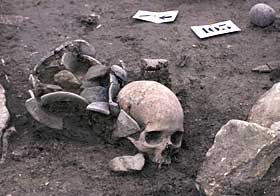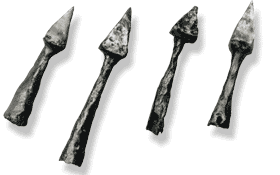- Home
- Research and interpretations
- Contributions of recent research
- The end of Entremont
The remains of two bodies abandoned in the collapse of islet 29 attest to the violent end of the Entremont settlement.
The Roman conquest of Provence in 123 BC has often been abusively described as an intangible terminus ante quem. However, all that has been found at Entremont, the supposed “capital” of the Salyens, cannot be posterior to this date. It is evident that in reflecting upon the end of Entremont we must take into account the problem posed by the status of the site and its association with textual and archaeological data: are we speaking of the end of the Salyen “city”, or the end of one oppidum among others on a hilltop near Aix-en-Provence, today called Entremont?
In the first case, we could not avoid attempting to reconcile the texts and the archaeology. In the second case, where we would forget the texts, an overly cautious approach could lead us to deprive ourselves of a precious “framework” for understanding and interpreting the discoveries made at the site. If we try to grasp the meaning of the site by temporarily ignoring its supposed role in descriptive history, and if we treat it as an oppidum among others, its end can be written in just a few words: after two battles that left their traces on the site, the oppidum was abandoned at around 100 BC.
If, on the other hand, we consider that it was indeed the last citadel of the Salyens (and the titular of the nearby Roman foundation, as Aquae Sextiae Salluviorum could indicate), we could propose that after a first destruction during the conquest of Sextius in 123, the oppidum continued to live for a while thanks to the Salyens who were reprieved with Craton. It would thus have been definitively destroyed during the troubled period provoked by a Salyen revolt, a phase that culminated in 90 BC when Rome sent a consul to quell the conflict.
Catapult bolts, arms used by the Romans.

